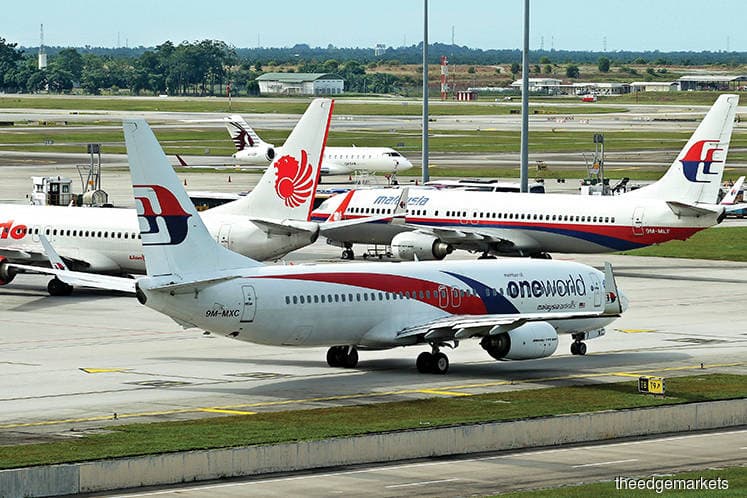
This article first appeared in The Edge Financial Daily on September 26, 2019
KUALA LUMPUR: Khazanah Nasional Bhd says its review of strategic options for beleaguered Malaysia Airlines Bhd is still ongoing and involves multiple parties that have expressed interest, but declined to name them.
A spokesperson for Khazanah told The Edge Financial Daily yesterday that ultimately, the airline’s future is a policy decision that impacts various stakeholders including Malaysia Airlines, its staff and customers.
In July, US-based investment bank Morgan Stanley was hired by Khazanah, which wholly owns Malaysia Airlines, as an adviser to explore possible options to turn around the loss-making airline, including a stake sale.
Year-to-date, the sovereign wealth fund has injected RM800 million into the country’s flag carrier, via its holding company Malaysia Aviation Group Bhd.
Khazanah was responding to a report The Malaysian Reserve published yesterday, quoting sources, that it is pushing for a merger between Malaysia Airlines and its loss-making low-cost counterpart AirAsia X Bhd (AAX).
The report also said the Khazanah management’s negotiation with AAX’s main shareholders is already at an advanced stage. AirAsia Group Bhd co-founders Tan Sri Tony Fernandes and Datuk Kamarudin Meranun together held a 31.59% stake in AAX as at March 20. When contacted yesterday, AAX declined to comment on the matter.
Fernandes, who is also group chief executive officer of AirAsia and non-executive director of AAX, has repeatedly said the low-cost airline group is not keen on buying Malaysia Airlines. In an interview with The Edge Malaysia weekly on Sept 12, he reiterated that AirAsia is not interested in Malaysia Airlines.
“You try to not make the same mistake [after the failed share swap deal in 2012]. Life is never as easy as one plus one equals two. There is politics [involved],” Fernandes said.
In 2012, the proposed share swap deal between the now-defunct Malaysian Airline System Bhd (MAS) and AirAsia would have seen Tune Air Sdn Bhd, the parent company of AirAsia, exchanging 10% of AirAsia shares for 20.5% of MAS stocks with state-owned Khazanah. However, the deal was scrapped amid pressure from the workers’ union at MAS.
During the interview, Fernandes also defended AAX’s long-haul low-cost airline model, saying it still works. “I believe in the model very much. I believe in it because there is demand. We are still not getting the fare versus cost of journey, but the demand (load factor) is still at 82% to 83%. We are flying to places that never had connectivity be it Jaipur or Lanzhou, and the demand is strong.”
Maybank Investment Bank Research aviation analyst Mohshin Aziz said there is a need for consolidation in the aviation industry as overcapacity and overlapping routes remain a challenge for airlines operating in Malaysia.
“It (a merger) is the best method to remove extra capacity,” he told The Edge Financial Daily, but stopped short of commenting on whether Malaysia Airlines and AAX would be a good fit.
An analyst from a local brokerage, who declined to be named, also deemed a consolidation as good for the industry, but is of the view that a merger between Malaysia Airlines and AAX does not make sense as they have different business models.
“I personally would not have picked AAX. For me, Malindo Airways Sdn Bhd seems to be a better match [for Malaysia Airlines] as they are both full-service carriers,” he said.
Hong Leong Investment Bank Research aviation analyst Daniel Wong said a merger between Malaysia Airlines and AAX would be subject to regulatory antitrust approvals as it would result in a reduction in competition within the industry.
“You have to look at the structure of the merger [if it happens]. How will AAX come in? How will the two airlines complement each other? We need to see how this merger will happen and the details involved before we can assess the impact,” he said.
“Mendacity and caprice are part and parcel of politics, particularly in Malaysia. Unfortunately for Malaysia Airlines [especially for its employees], is caught in a tangled web, woven over decades by the very people supposed to safeguard its well-being,” said aviation analyst Shukor Yusof of Endau Analytics.
“If the schism between Umno and PAS can be bridged, why not Malaysia Airlines and AAX?” he added.
AAX’s financial performance has been fairly volatile since its listing on Bursa Malaysia in 2013. In the past six years, only two years (2016 and 2017) have been profitable. The airline saw its net loss widen to RM163.78 million for the cumulative six months ended June 30, 2019, over 10 times more than the RM15.96 million net loss it posted a year earlier. This was due to deferred taxation, loss on disposal from the sale and leaseback of three aircraft and foreign exchange losses.
In a Sept 3 report, Mohshin said the risk of an equity call by AAX cannot be ignored due to the limited borrowing capacity in its balance sheet. The airline’s net gearing stood at 10.6 times as at end-June.
To date, there have been five failed attempts at restructuring the national carrier and setting it on a path to sustainable profitability, including during the 42 years when it was known as MAS.
According to filings with the Companies Commission of Malaysia (SSM), Malaysia Airlines’ net loss jumped 85% year-on-year to RM812.11 million for the financial year ended Dec 31, 2017. It lost RM2.35 billion between 2015 and 2017. It has yet to file its financial statements for 2018 with the SSM, but the airline did reveal that it finished 2018 with a marginally lower loss compared with a year ago.